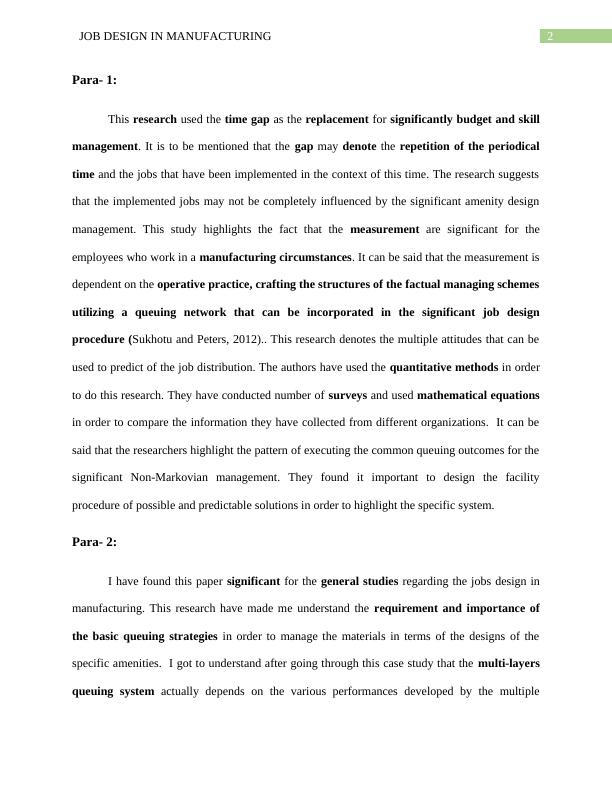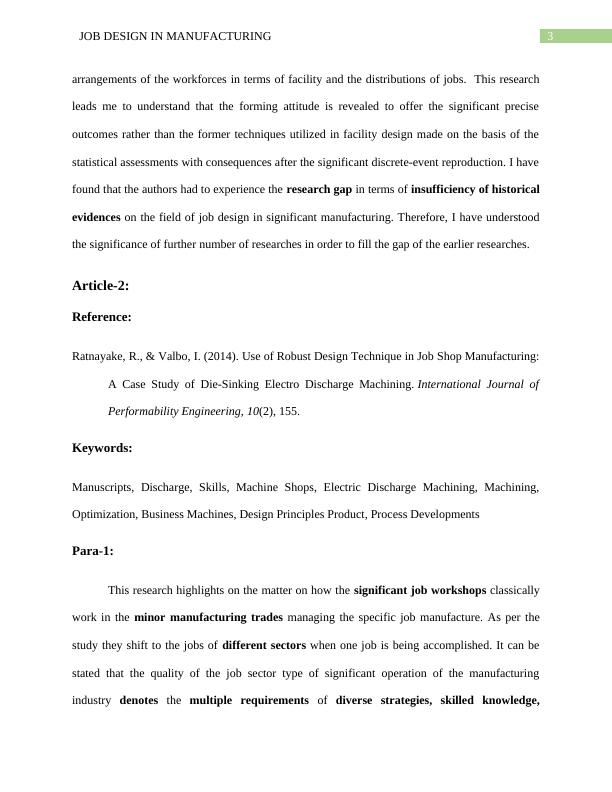Job Design in Manufacturing
Added on 2023-06-13
11 Pages2720 Words361 Views
Running Head: JOB DESIGN IN MANUFACTURING
Job Design in Manufacturing
Name of the Student
Name of the University
Author Note
Job Design in Manufacturing
Name of the Student
Name of the University
Author Note

1JOB DESIGN IN MANUFACTURING
Introduction:
This article aims to investigate the essential modifications over the years to the area of
job design as performed by number of significant Human Factors Engineers/ Ergonomists.
The perspective for this article are the predictable variations and modifications in the domain
of manufacturing that can be shaped by the significant International Drivers that involve a
defensible reaction. This article will draft an outline to highlight how the business drivers work
in the contemporary context of manufacturing. It can be said that the frameworks which may
already be observed are to denote the inferences for essential job design in the field of
significant manufacturing. These associations can also be interpreted as deceptive in further
domains.
Article-1:
Reference:
Sukhotu, V., & Peters, B. (2012). Modelling of material handling systems for facility design in
manufacturing environments with job-specific routing. International Journal of
Production Research, 1-18.
Keywords:
Materials Handling, Manufacturing Systems, Facility Layout, Queuing Networks, Facility
Design, Operational Research, Optimization, Job Routing
Introduction:
This article aims to investigate the essential modifications over the years to the area of
job design as performed by number of significant Human Factors Engineers/ Ergonomists.
The perspective for this article are the predictable variations and modifications in the domain
of manufacturing that can be shaped by the significant International Drivers that involve a
defensible reaction. This article will draft an outline to highlight how the business drivers work
in the contemporary context of manufacturing. It can be said that the frameworks which may
already be observed are to denote the inferences for essential job design in the field of
significant manufacturing. These associations can also be interpreted as deceptive in further
domains.
Article-1:
Reference:
Sukhotu, V., & Peters, B. (2012). Modelling of material handling systems for facility design in
manufacturing environments with job-specific routing. International Journal of
Production Research, 1-18.
Keywords:
Materials Handling, Manufacturing Systems, Facility Layout, Queuing Networks, Facility
Design, Operational Research, Optimization, Job Routing

2JOB DESIGN IN MANUFACTURING
Para- 1:
This research used the time gap as the replacement for significantly budget and skill
management. It is to be mentioned that the gap may denote the repetition of the periodical
time and the jobs that have been implemented in the context of this time. The research suggests
that the implemented jobs may not be completely influenced by the significant amenity design
management. This study highlights the fact that the measurement are significant for the
employees who work in a manufacturing circumstances. It can be said that the measurement is
dependent on the operative practice, crafting the structures of the factual managing schemes
utilizing a queuing network that can be incorporated in the significant job design
procedure (Sukhotu and Peters, 2012).. This research denotes the multiple attitudes that can be
used to predict of the job distribution. The authors have used the quantitative methods in order
to do this research. They have conducted number of surveys and used mathematical equations
in order to compare the information they have collected from different organizations. It can be
said that the researchers highlight the pattern of executing the common queuing outcomes for the
significant Non-Markovian management. They found it important to design the facility
procedure of possible and predictable solutions in order to highlight the specific system.
Para- 2:
I have found this paper significant for the general studies regarding the jobs design in
manufacturing. This research have made me understand the requirement and importance of
the basic queuing strategies in order to manage the materials in terms of the designs of the
specific amenities. I got to understand after going through this case study that the multi-layers
queuing system actually depends on the various performances developed by the multiple
Para- 1:
This research used the time gap as the replacement for significantly budget and skill
management. It is to be mentioned that the gap may denote the repetition of the periodical
time and the jobs that have been implemented in the context of this time. The research suggests
that the implemented jobs may not be completely influenced by the significant amenity design
management. This study highlights the fact that the measurement are significant for the
employees who work in a manufacturing circumstances. It can be said that the measurement is
dependent on the operative practice, crafting the structures of the factual managing schemes
utilizing a queuing network that can be incorporated in the significant job design
procedure (Sukhotu and Peters, 2012).. This research denotes the multiple attitudes that can be
used to predict of the job distribution. The authors have used the quantitative methods in order
to do this research. They have conducted number of surveys and used mathematical equations
in order to compare the information they have collected from different organizations. It can be
said that the researchers highlight the pattern of executing the common queuing outcomes for the
significant Non-Markovian management. They found it important to design the facility
procedure of possible and predictable solutions in order to highlight the specific system.
Para- 2:
I have found this paper significant for the general studies regarding the jobs design in
manufacturing. This research have made me understand the requirement and importance of
the basic queuing strategies in order to manage the materials in terms of the designs of the
specific amenities. I got to understand after going through this case study that the multi-layers
queuing system actually depends on the various performances developed by the multiple

3JOB DESIGN IN MANUFACTURING
arrangements of the workforces in terms of facility and the distributions of jobs. This research
leads me to understand that the forming attitude is revealed to offer the significant precise
outcomes rather than the former techniques utilized in facility design made on the basis of the
statistical assessments with consequences after the significant discrete-event reproduction. I have
found that the authors had to experience the research gap in terms of insufficiency of historical
evidences on the field of job design in significant manufacturing. Therefore, I have understood
the significance of further number of researches in order to fill the gap of the earlier researches.
Article-2:
Reference:
Ratnayake, R., & Valbo, I. (2014). Use of Robust Design Technique in Job Shop Manufacturing:
A Case Study of Die-Sinking Electro Discharge Machining. International Journal of
Performability Engineering, 10(2), 155.
Keywords:
Manuscripts, Discharge, Skills, Machine Shops, Electric Discharge Machining, Machining,
Optimization, Business Machines, Design Principles Product, Process Developments
Para-1:
This research highlights on the matter on how the significant job workshops classically
work in the minor manufacturing trades managing the specific job manufacture. As per the
study they shift to the jobs of different sectors when one job is being accomplished. It can be
stated that the quality of the job sector type of significant operation of the manufacturing
industry denotes the multiple requirements of diverse strategies, skilled knowledge,
arrangements of the workforces in terms of facility and the distributions of jobs. This research
leads me to understand that the forming attitude is revealed to offer the significant precise
outcomes rather than the former techniques utilized in facility design made on the basis of the
statistical assessments with consequences after the significant discrete-event reproduction. I have
found that the authors had to experience the research gap in terms of insufficiency of historical
evidences on the field of job design in significant manufacturing. Therefore, I have understood
the significance of further number of researches in order to fill the gap of the earlier researches.
Article-2:
Reference:
Ratnayake, R., & Valbo, I. (2014). Use of Robust Design Technique in Job Shop Manufacturing:
A Case Study of Die-Sinking Electro Discharge Machining. International Journal of
Performability Engineering, 10(2), 155.
Keywords:
Manuscripts, Discharge, Skills, Machine Shops, Electric Discharge Machining, Machining,
Optimization, Business Machines, Design Principles Product, Process Developments
Para-1:
This research highlights on the matter on how the significant job workshops classically
work in the minor manufacturing trades managing the specific job manufacture. As per the
study they shift to the jobs of different sectors when one job is being accomplished. It can be
stated that the quality of the job sector type of significant operation of the manufacturing
industry denotes the multiple requirements of diverse strategies, skilled knowledge,

End of preview
Want to access all the pages? Upload your documents or become a member.
